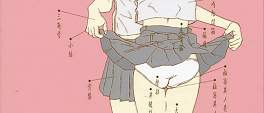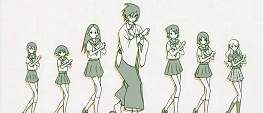



Tokyo Magnitude is the antithesis of most modern anime: sedate, unglossy and resolutely contained within the present time period. A premise concerning the terrifyingly plausible event of a high magnitude earthquake in urban Tokyo, it follows the journey of a young brother and sister - Yuuki and Mirai - and their chance meeting with courier Mari; miles from home this is their quest to reach their respective families. A bildungsroman veiled as a disaster series, the protagonist Mirai is taken from bratty and misanthropic to tolerating and finally, embracing.
beyond mediocrity - it transforms the blandly coloured drama into an emotive barrage
It would have been easy for the series to cast a bleak and unforgiving picture of humanity during a time of strife, but whether through slavish optimism or a cultural stubbornness, this is a story about people: at its best when meandering. The cast collides with friend and stranger alike, chance meetings that rarely last more than an episode but carefully craft and evolve Mirai's character from the bluntly cynical figure she starts out as. It is this endorsement of mankind which creates a rare empathy with nearly everyone introduced from the tirelessly working old man who lost his grandchildren to one of Mirai's classmates, bereaved by the loss of a parent. It is also this which enforces the near glacial pace that is the series biggest weakness.
Read the rest of this entry




How would a studio approach a manga known for its wordplay and focusing on a depressively suicidal teacher, a manga that was notoriously (even infamously) claimed to be untranslatable? Surely even SHAFT, known for their off-the-wall adaptations of other, more straightforward manga such as Pani Poni and Negima, could manage such a feat? They did, and with such reckless disregard for obstacles such as plot, continuity and sanity; Sayonara Zetsubou Sensei is bizarre, satirical, cynical and rambunctious and solidifies SHAFT as a skilled and confident studio.
each episode is a scatter-shot of styles and content, the speed and veracity of each bite-size skit causes as much humour as the subject matter
Describing the premise of the series would never be enough to encapsulate what it is actually about: the histrionically pessimistic Itoshki Nozomu is at thwarted in his attempts to kill himself by the outwardly naive and interminably optimistic Kafuka. This satisfies the first twelve minutes of the series as it then goes on a journey involving stalkers, hikkikomori, escape routes and courting rituals but most of the time it concerns itself with nothing in particular: a multicoloured collage of gags, perceptions on life and randomness. Sayonara Zetsubou Sensei has very little to say and has a damn good time saying it. The series doesn't cover a specific time frame or tell a coherent story, it is a staccato whimsy of wordplay and wonder; a möbius strip of pop-culture references and banter on the thralls of modern existence. If all this sounds like the series occupies a different existence to the rest of the world, you wouldn't be far off the mark. An episode can focus on one specific topic, often meandering along the way, veering off on tangents of logic but ultimately digging through an obscure subject such as what can be accepted as minimal culture, or clearing away impurities or escaping from blame and responsibilities. Other episodes which make up the majority of the twelve episode barrage concern themselves with frittering away on whatever shiny issue takes its fancy, the opening episodes concern themselves with introducing the core set characters and their associated archetypal personality quirks then strobing fanservice, insults, family members and all points in between. Episodes are sometimes over before one knows it, other times the closing animation can be just a punctuation mark before it continues, seemingly unabated.
Read the rest of this entry




Having a character in a series attempt to win an argument using squirrels seems like it would go down well around these parts; thankfully squirrel related tomfoolery is not all Minami-ke has to offer as it manages to break out of its well trodden, all-girl-school-comedy premise and develop into a raucous look at the life of a family of oddities and the selection of characters which get pulled into their orbit.
Characters, situations and comedy are stitched together so deftly that it's hard to think of Minami-ke as a series at all
The first season of Minami-ke seems to constantly better itself by proving time and time again that it will not beat a dead horse, providing capricious situations that seem patently obvious when shown, but on reflection take on Rube Goldberg-esque set up. For instance: Makoto, a typically brash and uninteresting character whose only lot in life seems to be to provide a catalyst for Chiaki's deadpan cynicism, add in the desire to visit the Minami household without incurring special kinds of wrath, mix in some typical gender-bending and atypical cross-dressing, sprinkle in some adoration for Haruka and the result is something that never seems anything less than hilarious. Time and time again the off-the-wall comedy provides sporadic moments of howling laughter buffered by constant amusement with a boy with a propensity for loosening his shirt and sparkling to the trio of straight-faced brothers who also share the name Minami.
Read the rest of this entry




Given such an auspicious and confusing opening three episodes, it would have been easy for ef to fall into obscurity and abstraction with deep symbolism and obscured plot; thankfully this is not the case and the series manages to make the absurdly stylistic symbolism part of itself while still a sometimes unique, not wholly original story which ends well at a petite twelve episodes.
the grayscale visions of Hiro, the stained glass technicolour of Chihiro and the sunset beaches for everyone
In between the astounding opening and changing ending are two stories: one about a high school boy trying to find colour in his world while trying to deal with the affections of two girls, one overt and another covert; the other is about a girl whose memory lasts only a scant thirteen hours before events begin slipping away and her relationship with a boy she meets at an abandoned train station. The plot may sound akin to an atypical dating-sim territory but the storytelling is first rate and deftly draws one into the world and its characters. The supernatural elements that nagged the opening episodes are present but downplayed; the ephemeral figure of a long haired woman who imparts advice to all of the central characters and then vanishes is never explained even slightly, the same with the silent, world weary caretaker of the memory-challenged protagonist. The only time these elements are brought to the fore is in the final moments of the series, hinting more at a desire for a second season rather than anything that would affect the first.
Read the rest of this entry




Bright, colourful and full of barely concealed nudity, Umisho is a raucous and energetic series built upon simple principles that are well executed. Far from being intelligent, thought-provoking or in-depth, each episode kicks meaningful story-telling and character development to the curb and manages to be a thirteen episode onsen and beach scenario combined.
Umisho never belittles the audience by repeatedly hammering at the most obvious of plot points
Beginning with the only iota of character justification in the entirety of the show, Kaname Okimura joined the school swimming club to learn how to swim after a run-in with a supposed mermaid and nearly drowning in his earlier years. With that pesky plot out of the way, the series gets down to basics and has young women losing their clothing at every available opportunity. Ostensibly the series follows the swimming team of Prefectoral Umineko Shougyou High as they compete and subsequently win local and regional tournaments; however this is mostly superfluous to the aforementioned nudity. Not one to be entirely sexist, the swim team captain is a bronzed, muscled specimen of a man who strips off with more frequency than the women although this stems from his naturist tendencies rather than the women who are ordinarily victims of circumstance.
Read the rest of this entry



















